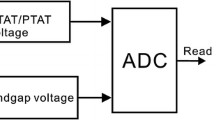Abstract
The multiplexed resistive arrays simplify the data collection with reduced connections and circuit complexity. However, the effect of crosstalk in these cases becomes inevitable. The crosstalk is caused due to the leakage currents in the multiplexer channels as well as the parasitic paths among the non-selected elements in the array. This paper analyses a circuit arrangement capable of suppressing crosstalk in 2D resistive sensor arrays. The proposed circuit employs transistors and diodes to modify simple voltage feedback commonly used for crosstalk reduction. The paper includes simulation results, approximate mathematical model for the “element under measurement” and other practical aspects of the circuit arrangement, such as the array size or the bias resistance. Finally, the circuit is compared (based on the simulation results) with two known circuit arrangement from the literature. The suggested circuit is clearly capable of eliminating crosstalk better than previously known methods. The analysis also reveals that the circuit is sensitive to temperature variations and must be modeled with temperature calibration factors for better model accuracy.














Similar content being viewed by others
References
G. Agranov, V. Berezin, R. Tsai, Crosstalk and microlens study in a color CMOS image sensor. IEEE Trans. Electron Devices 50, 4–11 (2003)
T. Dalessio, Measurement errors in the scanning of piezoresistive sensors arrays. Sens. Actuators A Phys. 72, 71–76 (1999)
A. Devices, MOS 4-/8-Channel High Performance Analog Multiplexers FEATURES 44 V supply maximum ratings VSS to VDD analog signal range Low on resistance (\(100\,\Omega \) maximum) Low power (ISUPPLY \(< 75 \,\upmu \text{A}\)) Fast switching Break-before-make switching action Plug-in replacement f. http://www.analog.com/media/en/technical-documentation/data-sheets/ADG408_409.pdf. Accessed 17 Aug 2019
M.S. Kim, H.J. Shin, Y.K. Park, Design concept of high-performance flexible tactile sensors with a robust structure. Int. J. Precis. Eng. Manuf. 13(11), 1941–1947 (2012). https://doi.org/10.1007/s12541-012-0256-3
H. Liu, Y. Zhang, Y. Liu, M. Jin, Measurement errors in the scanning of resistive sensor arrays. Sens. Actuators A Phys. 163, 196–204 (2010)
MAX4684 \(0.5\,\Omega /0.8\,\Omega \) low-voltage, dual SPDT analog switches in UCSP—Maxim. https://www.maximintegrated.com/en/products/analog/analog-switches-multiplexers/MAX4684.html. Accessed 17 Aug 2019
D. Prutchi, M. Arcan, Dynamic contact stress analysis using a compliant sensor array. Measurement 11, 197–210 (1993)
R. Saxena, R. Bhan, C. Jalwania, P.S. Rana, S.K. Lomash, Characterization of area arrays of microbolometer-based un-cooled IR detectors without using ROIC. Sens. Actuators A Phys. 141, 359–366 (2008)
R. Saxena, N. Saini, R. Bhan, Analysis of crosstalk in networked arrays of resistive sensors. IEEE Sens. J. 11, 920–924 (2011)
R.S. Saxena, R.K. Bhan, A. Aggrawal, A new discrete circuit for readout of resistive sensor arrays. Sens. Actuators A Phys. 149(1), 93–99 (2009). https://doi.org/10.1016/j.sna.2008.10.013
R.S. Saxena, R.K. Bhan, N.K. Saini, R. Muralidharan, Virtual ground technique for crosstalk suppression in networked resistive sensors. IEEE Sens. J. 11(2), 432–433 (2011). https://doi.org/10.1109/JSEN.2010.2060186
T.H. Speeter, A tactile sensing system for robotic manipulation. Int. J. Robot. Res. (1990). https://doi.org/10.1177/027836499000900603
D. Stratos, G. Maria, F. Eleftherios, L. George, Comparison of three resistor network division circuits for the readout of \(4 \times 4\) pixel SiPM arrays. Nucl. Instrum. Methods Phys. Res. Sect. A Accel. Spectrom. Detect. Assoc. Equip. 702, 121–125 (2013)
L.C. Wang, K.T. Tang, S.W. Chiu, S.R. Yang, C.T. Kuo, A bio-inspired two-layer multiple-walled carbon nanotube-polymer composite sensor array and a bio-inspired fast-adaptive readout circuit for a portable electronic nose. Biosens. Bioelectron. 26(11), 4301–4307 (2011). https://doi.org/10.1016/j.bios.2011.04.015
J. Wu, J. Li, Approximate model of zero potential circuits for the 2-D networked resistive sensor array. IEEE Sens. J. 16, 3084–3090 (2016). https://doi.org/10.1109/JSEN.2016.2530692
J. Wu, L. Wang, Cable crosstalk suppression in resistive sensor array with 2-wire S-NSDE-EP method. J. Sens. (2016). https://doi.org/10.1155/2016/8051945
J. Wu, L. Wang, J. Li, Design and crosstalk error analysis of the circuit for the 2-D networked resistive sensor array. IEEE Sens. J. 15, 1020–1026 (2015)
J. Wu, L. Wang, J. Li, A. Song, A novel crosstalk suppression method of the 2-D networked resistive sensor array. Sensors (Switzerland) 14(7), 12816–12827 (2014). https://doi.org/10.3390/s140712816
J. Wu, L. Wang, J. Li, Z. Yu, A small size device using temperature sensor array. Chin. J. Sens. Actuators 24, 1649–1652 (2011)
Y. Yang, M. Cheng, W. Chang, L. Tsao, An integrated flexible temperature and tactile sensing array using PI-copper films. Sens. Actuators A Phys. 143, 143–153 (2008)
Y. Yang, M. Cheng, S. Shih, X. Huang, A \(32 \times 32\) temperature and tactile sensing array using PI-copper films. Int. J. Adv. Manuf. Technol. 46, 945–956 (2010)
X. Zhang, Y. Zhao, X. Zhang, Design and fabrication of a thin and soft tactile force sensor array based on conductive rubber. Sens. Rev. (2012). https://doi.org/10.1108/02602281211257506
Author information
Authors and Affiliations
Corresponding author
Additional information
Publisher's Note
Springer Nature remains neutral with regard to jurisdictional claims in published maps and institutional affiliations.
Rights and permissions
About this article
Cite this article
Chowdhury, S.R., Bhondekar, A.P., Kumar, R. et al. Analysis of a Novel Circuit Arrangement to Suppress Crosstalk in 2-D Resistive Sensor Arrays. Circuits Syst Signal Process 39, 1227–1243 (2020). https://doi.org/10.1007/s00034-019-01242-7
Received:
Revised:
Accepted:
Published:
Issue Date:
DOI: https://doi.org/10.1007/s00034-019-01242-7




